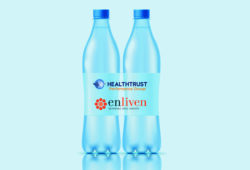HealthTrust Members Defend Against Disasters With Comprehensive and Well-executed Emergency Operations Plans
You can’t always anticipate a disaster or emergency—in a moment’s notice, a normal day can transform into a dramatic, movie-like scene. When it comes to natural disasters, such as hurricanes and tornadoes, and man-made emergencies, such as multivehicle accidents and mass shootings, it’s paramount that nurses, clinicians and support staff are well-trained and prepared to respond quickly and appropriately. Advance preparation, planning and practice are a facility’s lifeline to gaining control over these chaotic and often dangerous situations.
That’s why hospitals are required to have an Emergency Operations Plan (EOP), a written plan that details how a facility will respond to and recover from all types of disasters. An all-hazards EOP includes six elements mandated by the Joint Commission’s Emergency Management Standards: communications, resources and assets, safety and security, staff responsibilities, utilities and clinical, and support activities.
Some hospital systems, such as Nashville, Tennessee-based HCA, have created a network-wide EOP for its facilities. It’s important for a hospital, even if part of a health system, to tailor its own plan, explains Michael Wargo, AVP of enterprise preparedness and emergency operations at HCA.
“Each facility has unique features,” Wargo says. “Hospital leaders should do an assessment of their facility and infrastructure and look at hazards based on climate, geographical location and other community components.”
The Joint Commission also requires organizations to test its EOP twice a year—either in response to an actual emergency or in a planned exercise. Periodic exercises can enable facilities to assess how the plan works in real time, the effectiveness of the plan’s logistics, human resources, training, policies and procedures—and the limits of an emergency management system.
“These exercises give us a good look at how resilient we are,” says Wargo, noting that HCA-affiliated hospitals complete more than the two mandated drills each year.
Combating Infectious Diseases
Think Like an Investigator
In December 2014, the first cases of the Ebola virus were detected in the United States. The deadly virus, which originated in West Africa, caused widespread panic, though there were only eight confirmed U.S. cases. While the CDC says Ebola is no longer a threat, the outbreak serves as a reminder that tested procedures are needed during an infectious disease outbreak. The key is preparation and training.
Grainger (HealthTrust Contract No. 148), a leading provider in the industrial supply industry, helps hospitals successfully prepare for crises before they happen, explains Kym Orange, the healthcare strategy manager at Grainger.
“We offer the broadest product portfolio in the market through an emergency preparedness-specific catalog, a dedicated section of Grainger.com that helps tailor plans for specific emergencies, and webinars aimed to educate hospital leadership on the latest in crisis prevention and response,” Orange says.
When an emergency like Ebola—or another infectious disease—strikes, Grainger team members extend branch operation hours and assist as support resources in emergency operations centers. “We act quickly to surge inventory levels for critical products and, if necessary, prioritize specific items for first responders and first receivers,” Orange says. “Through coordination and consolidation of supply chain efforts, we’re able to deliver critical items to multiple locations.”
When the Ebola crisis hit the United States in 2014, Grainger received a number of inquiries from HealthTrust members looking for assistance to protect healthcare workers from potential exposure. At the time, many healthcare organizations were struggling to identify and secure the appropriate personal protective equipment from their medical surge suppliers. They turned to Grainger.
“We played an integral role in bringing together HCA, HealthTrust, Grainger suppliers and manufacturers to identify, source and even develop the critical personal protective equipment needed for facilities and employees to manage the response,” Orange says. “We were able to accelerate and prioritize the delivery of products to impacted facilities to keep them operating safely.”
Physicians can play an important role in combating infectious diseases, says Michael Wargo, AVP of enterprise preparedness and emergency operations at HCA.
“Physicians should have situational awareness of what’s happening in different pockets of the world,” he says. “So if patients come in with flu-like symptoms and have traveled out of the country recently, they’ll be asked where they went and how long after they returned that they got ill. Physicians have to be like investigators collecting information.”
Three HealthTrust member facilities, faced with a variety of emergencies, have needed the experience of these hypothetical exercises when they were forced to shift into real-life crisis mode. Their leaders share the lessons learned on the front lines and ways all facilities can strengthen their emergency response capabilities.
Hurricane Matthew: Bring in the Cavalry
In October 2016, Hurricane Matthew ripped through Myrtle Beach, South Carolina, resulting in nearly $22 million in damages to city infrastructure, homes, buildings and dune walkovers, as well as in lost revenue. But in the days leading up to the storm, the leadership team from Myrtle Beach’s Grand Strand Medical Center—a member of HCA’s South Atlantic Division—met daily to prepare. The team, representing multiple hospital departments called into action when the EOP is implemented, discussed the logistics of storm preparedness to ensure the facility had sufficient supplies, resources and personnel.
As the hurricane approached, the governor issued a mandatory evacuation and Myrtle Beach was put under curfew restrictions—though the hospital was exempt. Following the hospital’s EOP, the staff at Grand Strand Medical Center secured extra supplies and resources, as well as decreased the patient load by canceling elective surgeries and outpatient procedures. The leadership team organized places for employees to spend the night at the hospital, using air mattresses and extra stretchers as makeshift beds and pitching tents in outpatient areas. Nurses volunteered to work all weekend, even as their own families were evacuating.
“We were aggressive in our preparations for the storm,” says Tiffany Keys, chief nursing officer at Grand Strand Medical Center. “There wasn’t a sense of impending doom, because we knew we had done everything we could do.”
What the hospital couldn’t do was prepare for the storm’s aftermath: fallen trees, road debris, destroyed homes and transportation nightmares.
“We had 16 nurses call out on Sunday morning,” Keys says. “Many of these employees were trying to sandbag to keep water from entering their homes. One nurse, who had worked all weekend, arrived home to find a tree had landed on his house. Obviously none of these nurses could come in.”
During a standard emergency operations call with leadership from the South Atlantic Division office on Sunday morning, Keys relayed her staffing challenges. Division leaders escalated the need to the HCA corporate headquarters in Nashville.
Thanks to a partnership with HealthTrust Workforce Solutions, 18 multispecialty nurses—nine from Nashville and another nine from Houston, Texas—were on assignment at Grand Strand Medical Center by Sunday evening.
“To see a group of nurses who were happy, well rested and excited to help was emotional,” Keys says. “It was the cavalry coming in. Because of their help, we could continue serving our community.”
HealthTrust Workforce Solutions participates in calls with the HCA Emergency Operations Command Center, explains Paula Philips, vice president of clinical operations at HealthTrust Workforce Solutions. “Once HCA realizes a storm is coming or there’s a disaster, it engages us to start monitoring the situation.”
“We were staying up-to-date on what was happening in the area—everything from the weather to staffing and generators—and we had started building a pool of nurses who would be available to travel under short notice,” adds John Lowe, the Eastern Region vice president of HealthTrust Workforce Solutions.
The Boston Marathon: Thinking on Their Feet
On April 15, 2013, during the 117th Boston Marathon, two crude homemade bombs exploded near the finish line—the first at 2:49 p.m. and the second just 12 seconds later. Three spectators died from injuries sustained at the scene, and more than 250 people were wounded, some very seriously. Physicians and nurses from Boston Medical Center (BMC), as well as other Boston-area hospitals, were staffing medical tents at the race when the explosions happened.
“We received a phone call from one of the physicians in the medical tent at the finish line, alerting us that something had blown up,” says Maureen McMahon, director of emergency management at BMC. “At that point, we started activating our emergency response plan. Within three to four minutes, we had confirmation that the explosions were bombs.”
Physicians immediately began tending to the wounded on-site, before transporting them to surrounding hospitals. The first patient arrived eight minutes after the explosion. Though not the closest hospital to the race route, BMC was the most easily accessible. Within a half-hour, there were 23 patients at the facility. Of those, 19 were admitted, 10 in critical condition. Five more victims with minor injuries trickled in over the next few days.
HealthTrust to the Rescue
When a worst-case scenario hits your facility, it’s wise to have contacts in your back pocket who can assist with disaster recovery. With HealthTrust-contracted suppliers, members will get preferential treatment after a crisis happens; emergency mitigation services, with the goal of immediately containing or reducing the effects of a disastrous event; and practical services such as air ambulances and priority access to generators and other vital supplies and equipment.
HealthTrust’s contracted suppliers are ServiceMaster Recovery Management (SRM; Contract No. 7304) and FirstOnSite Restoration USA Services (Contract No. 7241). These suppliers provide general labor, commercial equipment rentals and disaster-related consumable items. Services include water, fire, smoke, mold/microbial restoration and remediation; emergency power and lighting; dehumidification; and temporary HVAC. Also available are reconstruction services, building and site stabilization, and critical content restoration.
“During emergency situations, having a fully vetted restoration partner with expertise and extensive experience working in the healthcare environment is vital to the recovery process,” says Jabin Newhouse, SRM’s account representative for HealthTrust.
Unlike with insurance plans, these services don’t require a monthly premium—you’re only charged when you need to engage the services. Each recovery service supplier will also provide required documentation to your insurance adjuster.
“HealthTrust has suppliers with close relationships with major carriers and can facilitate a fast claims process,” says Ward Martindale, manager, strategic sourcing, HealthTrust Purchased Services.
“Everyone pitched in,” McMahon says. “We typically activate our Emergency Operations Plan under a variety of circumstances so that our staff are prepared and can quickly jump into action. The bombing, however, was unlike anything we had ever experienced, so our staff had to think on their feet that day. But they knew the procedures from multiple drills, so they were able to adjust to the unique conditions.”
McMahon credits the incident management team at BMC for its quick response. When the emergency plan is activated, leaders from key hospital departments report to the emergency department for a briefing and are then responsible for coordinating their team. During this incident, clinicians and nurses lined the hallways, waiting to be called in to assist. It was impressive how cooperative everyone was, McMahon says, calling it a “true team effort.”
What the hospital’s EOP didn’t account for, however, was the emotional toll the day would have on its staff.
“The bombers blew up our city, and we took it personally,” McMahon says. “It affected us all. Every employee who was there that day and those who were not still remember the horror. We did a lot of work on that first day and in the days that followed to ensure our staff was not only physically OK, but emotionally OK.”
This included convening a team at BMC with the sole purpose of comforting staff members. Massage chairs and “puppy vans” were brought in to help them relax. It worked.
“The puppy van turned into a new program at the hospital,” McMahon explains. “Now we allow employees to bring their specially trained dogs to visit patients and staff. It brings a smile to their faces. That all started from the puppy vans after the bombing.”
Hurricane Ike: Merge Medical and Security Teams
A hospital evacuation during a hurricane is tricky. But evacuating 250 career criminals during a hurricane? That’s the challenge Troy Sybert, M.D., was met with in September 2008 when Hurricane Ike plummeted the coast of Galveston, Texas.
Sybert, who is now a healthcare consultant in Johnson City, Tennessee, was then the chief medical officer of the state prison hospital, a 200-bed facility at the University of Texas Medical Branch. When he received word that the prisoners would have to evacuate the hospital, Sybert and his colleague, the prison warden, led coordination efforts.
“The biggest challenge was finding a place to take them,” he says. “These were hardened, penitentiary criminals, and some hospitals were hesitant to take them because of the increased security risk.”
Sybert’s team nonetheless managed to transport all 250 patients to new locations within 20 hours. Some went to prison nursing facilities, while others were moved to regional hospitals that had experience treating inmates.
“We got the job done because of the relationship and understanding between the medical team and security team,” he says. “As a doctor, your goal is to take care of people. It was an exciting opportunity to see how two teams with different expertise could accomplish such a major feat in less than 24 hours.”
Are You Prepared?
Elements of an Emergency Operations Plan
Developing a disaster preparation and response plan—and practicing it—is crucial to a healthcare facility’s continuity during an emergency situation, experts advise. The speed and manner of disaster response are critical to a provider’s recovery and rehabilitation.
Most facilities abide by a standard emergency preparedness framework, explains Michael Wargo, the AVP of enterprise preparedness and emergency operations at HCA, but there isn’t a one-size-fits-all plan. Every facility has its own nuances, making it essential for its leaders to craft a detailed plan that is specific to the hospital’s location and surroundings.
So what should your checklist include? Here are some ideas from the World Health Organization:
A designated command center. Find a suitable location, whether physical or virtual, and communicate that location widely. Include representatives from administration, communications, security, emergency medicine, nursing administration, human resources, pharmacy, infection control, respiratory therapy, engineering and maintenance, laboratory, nutrition, supply chain, and laundry, cleaning and waste management. Make sure all representatives know their duties and responsibilities.
Communications plan. Include a phone (text or email) tree in your plan to contact staff members. Designate a space for press conferences (away from the emergency department and command center) and appoint a spokesperson to communicate.
Safety and security. Work with your security team in advance to identify areas of vulnerability. Talk with local law enforcement to determine procedures for integrating law enforcement in hospital security operations, if the situation warrants.
Triage. Appoint an experienced triage nurse or clinician to oversee operations, and ensure that the triage site is close to the emergency department (ED), operating room and intensive care unit.
Surge capacity. Designate areas for patient overflow and identify methods of expanding hospital inpatient capacity. Ensure staff knows to prioritize or cancel nonessential surgeries when necessary.
Human resources. Keep an updated staff contact list in the plan, and establish a contingency plan for providing food, water and shelter. Mandate training for clinical areas that may be in higher demand during an emergency, such as the ED and intensive care, so staffing isn’t an issue.
Logistics and supply chain. Stockpile essential pharmaceuticals and supplies, such as linens, which often run out. Maintain an updated inventory of all equipment and supplies. List contact information for suppliers of emergency supplies and services, as well as a list of backup suppliers.
Post-disaster recovery. Organize a debriefing for staff within 24–72 hours after the emergency incident to assist with coping and recovery. Take an assessment of damage to the hospital building, if any. Be sure to recognize your staff and volunteers for their extra efforts during an emergency response.
Share Email Disaster & Emergency Preparedness, Facilities Management, Q1 2017, Surgery





